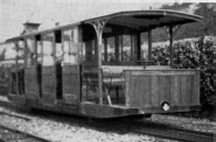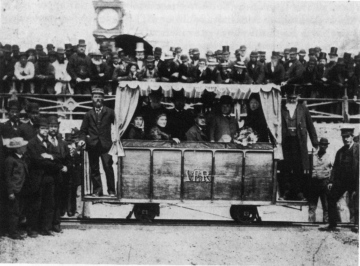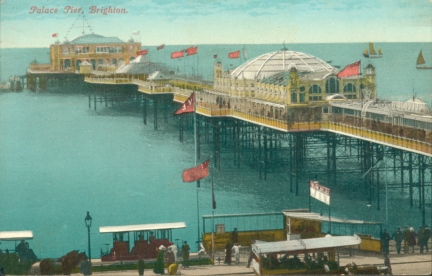
MAGNUS VOLK'S ELECTRIC RAILWAY

Typical semi-open car
The first electrified public railway in the world opened in Germany in 1881. It extended from the Berlin Anhalt railway station to the suburban station of Lichtersfelde, a distance of about 2.4 km (1½ miles). The line was electrified at 100v DC. The car ran at up to 48 km/h (30 mph) and carried 26 passengers. Services commenced on May 12th.
The second electric railway with a public service, started running in England, in 1883. It was the first electric railway in the United Kingdom, and was the brain-child of Magnus Volk. The railway was in the south coast seaside town of Brighton, in the county of Sussex.
Magnus Volk was born in Brighton in 1851. His father was a German clock-maker. The young Magnus was deeply fascinated by the adolescent electrical engineering industry, seeking in his own town to develop visionary electrical schemes that would nevertheless have sound utilitarian value.
By the age of 30, Magnus had already begun to acquire a reputation as an electrical expert, for in 1881 he was awarded a coveted Gold Medal for a street fire alarm system of the sort that was installed in many towns and cities right up to the 1940s. In the following year, he installed in his own house the first electric lighting and the first telephone that this large town had known. With considerable foresight, the Brighton Corporation appointed the young man to be their first Electrical Engineer. In that capacity, in the following year, he installed what was the largest electric lighting system in Britain, when he illuminated the Royal Pavilion, the seaside palace built for King George IV.
The following year he built the first part of the railway that was to be a lasting memorial of his pioneering energy and genius. This was a railway about 0.402 km (¼ mile) running along the sea shore from the old Chain Pier (soon afterwards destroyed in a great storm) westwards to a second terminus at a place then known as Swimming Arch.
The line was laid to a 0.610 (24") gauge, with running rails spiked to longtitudinal sleepers. The running rails carried the 50v DC traction supply.
The first car that was built for this line consisted of a small open wooden wagon or truck, with transverse wooden seats accommodating about 10 passengers. At each end of the wagon was a small platform fitted with the controls, upon which platform the driver stood. At each corner of the wagon was a vertical post, the four posts supporting a light roof or canopy. The canopy was decorated with an ornamental fabric pelmet on all sides, and each of the four posts supported two ornamental fabric curtains. The car ran on 4 small wooden wheels shod with steel tyres. It could well be describes as looking rather like a four poster bed sitting inside a railway truck. Approximate dimensions were:- Length overall 3.505m (138", Central passenger compartment length 2.438m (96") Wheelbase 1.524m (60") Wheel diameter 0.457m (18"). It was driven by a single motor.

Official Opening of Volk's Electric Railway 1883
On the 4th August 1883, eight weeks before the opening of the Portrush Giants Causeway railway in Ireland, the Mayor of Brighton opened this first section of the Volks Electric Railway, watched by a large and excited crowd of spectators. The little car, with 8 passengers aboard, gathered speed as it made its way towards the Chain Pier, from where it delivered its passengers safely back to the Swimming Arch Terminus. The railway then provided a daily service until the advent of winter.
Magnus Volk was not content to leave matters there, he had successfully demonstrated an electric railway popular with both visitors and residents alike. Now support and finance began to become available, and as soon as winter arrived, Magnus had the original track lifted. It was then re-laid and extended early in 1884, now running from Swimming Arch to Paston Place, a distance of 2.62 km (1.625 miles). The gauge was increased to 0.838m (33") the railes now being spiked to conventional transverse sleepers/ties. The railway was fenced off with stout wire mesh, and the supply voltage increased three-fold. A large number of pedestrian crossings were provided, and at these, sections of electrically dead running rails were fitted. Two dynamos of two different types were obtained to provide a 150v DC power supply to the railway , one of the dynamos being of the distinctive Edison pre 1884 long magnet bi-polar type. Whilst all this was going on, new electric railcars were being designed and built. These were strongly constructed, mainly from wood, and were of substantial size. They had bigger wheels and a considerably longer wheelbase than the 1883 car, double the passenger capacity and were much speedier. There was a platform at each end where the motorman stood, and the the controller was mounted, of all places, on the inside of the roof, above the motorman's head. All the cars were roofed. As it was intended to run the cars separately, no couplings were fitted, but all the cars carried a single spring buffer, mounted centrally, at both ends. Summertime (open sided) and Wintertime stock was provided. Enough of the cars had been delivered to enable services to commence in the Spring of 1884, on the 4th April (extensively re-built, the first of these cars was still in service when the railway closed for the duration of World War 2, the whole of Brighton seafront being taken over by the military and extensively fortified in the summer of 1940). To design and build an electric railway and its rolling stock in less than a year is an incredible feat, and this was in 1884! Not surprisingly for such a pioneer service, two serious troubles became apparent within the first couple of years of operation. The first was a very low traction voltage at the outer ends of the line, especially when several cars were running, the entire line being fed at only one point by the power station at Paston Place. The second was poor riding of the cars, with hunting and lateral oscillations, not only creating discomfort, but also excessive wear and tear of the rails and wheel flanges.
The first problem was caused not only by the ohmic losses in the rails (there were no cables to feed the line at its extremities) but also by excessive leakage of traction current from the positive to the negative running rail through the wooden sleepers, which soon became salt impregnated, and from the positive running rail to earth, somewhat reduced since the whole line is laid on a pebble beach rather than upon an earth foundation. The second problem was due to a gauge incompatibility between the track and cars, which ought not to have occurred, since the correct relationship between track gauge and rolling stock wheelset gauge had been established long before this line was built. The incredible speed with which the line, its rolling stock and powere supply were designed and built in 1884 was the probable cause of this misjudgement whch caused the wheelsets to be a very loose fit upon the track.
Magnus realised that neither of these two problems could be tolerated, and in the winter of 1886 one running rail was moved inwards to reduce the track gauge to 0.862m (32.5") which improved the ride very considerably. At the same time, both the running rails were connected together, and the negative sides of the 100v traction supply, and a positive conductor rail, mounted upon proper insulation, was laid centrally between the two running rails. The cars were fitted with central pick-up shoes to suit this much improved arrangement. The conductor rail was gapped at each of the pedestrian crossing places. With these modifications, the elecctrical supply problem was largely overcome.
Magnus Volk's inventive genius was by no means exhausted, and in 1893 he designed and built an even more ambitious railway, the Brighton and Rottingdean Seashore Electric Tramroad, surely the most unusual and extraordinary railway ever built. This is described in its own webpages elsewhere on this website. Unfortunately, this railway no longer exists.
In 1901, a major extension westwards was completed from Paston Place to Black Rock via the Banjo Groyne. The car sheds are situated at Paston Place, and the running line passes through them. When the railway is not running, the running line through the sheds becomes another car berthing line. The railway continued largely unchanged until 1933, when it was cut back by 0.201 km (0.0125 mile) at its Western extremity, from Bathing Arch to the Aquarium, its current Western Terminus (plans have been submitted, several times over the last 25 years, to restore the Aquarium-Bathing Arch section).

Palace Pier Brighton, Aquarium station in foreground c.1925
Magnus Volk maintained a lively interest in the running of his railway right up to 1937, when he died at the age of 88. He was elected a Posthumous Member of this Institute on the 26th June 1995.
At his death, the railway passed into the hands of his family, who ran it until April 1940 when it was taken over by Brighton Corporation. But after a few months, as previously noted, it was closed because of World War 2, and abandoned for the next 5 years. It had by then carried 30,000,000 passengers.
When the military vacated Brighton seafront at the end of the war, the railway formation, due to war damage, neglect and salt-air corrosion, was quite unusable. The power station, built in a man-made cavern in the chalk cliffs at Paston Place, emerged from the wartime years largely unscathed. This was a minor miracle!
Brighton Corporation relaid the railway, using new heavier rails on new transverse sleepers/ties. The conductor rail was relaid on insulators with conical rain sheds. Considerable stretches of the re-laid conductor rail consisted of the least rust-corroded lengths of the old pre-war running rails welded together, and this was supplemented by entirely new flat bottomed rail of a similar profile and size.
The railway has 3 stations, Aquarium, Paston Place and Black Rock. It is a single track from end to end, with a passing loop at Paston Place, and two others, each one roughly midway between Paston Place and one of the two termini. When a children's playground (Peter Pan's Playground) was built at Paston Place, Paston Place station was renamed Playground, and when, years later, a Marina was built at Black Rock, Black Rock was renamed Marina. Following a fatal accident to a pedestrian in 1950, all 13 pedestrian crossings were equipped with red/green warning lights. The crossing at Playground is also a vehicle crossing.
The original power station of 1884 was still in use for several years after the post-war rebuilding, but it was then replaced with a new mercury arc rectifier installation. It is unfortunately likely that the original generating equipment, of the greater interest and historical value, was not preserved. Two cars from the Southend Pier railway, dating from 1898, were purchased in 1949, when the Southend railway was re-equipped. These cars were re-gauged from 1.067m (42") to 0.826m (32.5"). This brought the number of servicable cars up to nine. About this time, all the cars were equipped so that they could be coupled into pairs and run as two car trains at times of peak demand.
Brief details of the nine cars are as follows:
| CAR NO: | BUILT | TYPE | PASSENGERS |
| 1 | 1910 | TOASTRACK | 40 |
| 2 | 1926 | TOASTRACK | 40 |
| 3 | 1892 | SEMI OPEN | 40 |
| 4 | 1892 | SEMI OPEN | 40 |
| 5 | 1901 | SEMI OPEN | 40 |
| 6 | 1901 | SEMI OPEN | 40 |
| 7 | 1901 | SEMI OPEN | 40 |
| 8* | 1898 | TOASTRACK | 48 |
| 9* | 1898 | TOASTRACK | 48 |
* Ex Southend cars - now being withdrawn for preservation, one in Southend, one elsewhere.
The railway can only afford to employ a very small staff, which is at full stretch during the peak summer season. Most of the major maintenance, both of the track and the railcars is necessarily carried out during the winter months.
In 1996 a volunteer supporter group, with the name Volk's Electric Railway Association (VERA) was set up to assist the paid staff, and this group provides invaluable help in the area of promoting the railway's expansion. This group is totally unconnected with the Railway owners, The Brighton & Hove Corporation and indeed its views and proposals have not always mirrored those of the Corporation.
Magnus Volk, the founder of the railway that bears his name, is not the only V.E.R engineer who is a member of the Institute. The entire staff of Volk's Electric Railway joined the Institute in March 1998, and in the same month the Railway became a Corporate Member of the Institute. This connection with the historical origins of the railway electrification industry is, for the fledgling Institute, a humbling experience and a quite undeserved honour.
J.E.M.S
Photo credits: H.W.A Linecar, Brighton Museum & Art Gallery, IIREE archives.

|

|
|
|
|